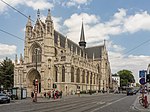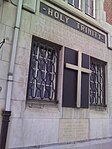Egmont Palace

The Egmont Palace (French: Palais d'Egmont, Dutch: Egmontpaleis), also sometimes known as the Arenberg Palace (French: Palais d'Arenberg, Dutch: Arenbergpaleis), is a neoclassical palace in Brussels, Belgium. It was originally built between 1548 and 1560 for Countess Françoise of Luxembourg and Lamoral, Count of Egmont, though its appearance was heavily modified in the 18th century. It was partly destroyed by fire in 1892, after which it was once again reconstructed. Today, it houses the Belgian Ministry of Foreign Affairs. The palace is situated in the Sablon/Zavel district (south-eastern part of Brussels' city centre), between the Rue aux Laines/Wolstraat and the Square du Petit Sablon/Kleine Zavelsquare. This site is served by Porte de Namur/Naamsepoort metro station (on lines 2 and 6 of the Brussels Metro), as well as the tram stop Petit Sablon/Kleine Zavel (on lines 92 and 93).
Excerpt from the Wikipedia article Egmont Palace (License: CC BY-SA 3.0, Authors, Images).Egmont Palace
Rue des Petits Carmes - Karmelietenstraat, City of Brussels Pentagon (Brussels)
Geographical coordinates (GPS) Address Nearby Places Show on map
Geographical coordinates (GPS)
| Latitude | Longitude |
|---|---|
| N 50.838611111111 ° | E 4.3577777777778 ° |
Address
Rue des Petits Carmes - Karmelietenstraat 20A
1000 City of Brussels, Pentagon (Brussels)
Belgium
Open on Google Maps










